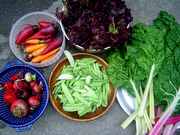

|
| Vegetable Varieties for Gardeners is a citizen science program
|
|
|
|
'Chimayo Calabaza' Squash - Winter |
| |
| Sub-Category: |
Misc.
|
| |
|
| Sub-Category 2: |
| | Description: |
Cucurbita argyrosperma. Cushaw type fruit without a large neck originally from Chimayo, New Mexico. Vines produce green and white striped winter squash that turns orange when mature. A winter squash, but great as a summer squash, and has loads of edible flowers and seeds.
|
| Days To Maturity: |
NA
|
| Seed Sources: |
Native Seeds/SEARCH - updated in 2014
|
| |
| Rating Summary |
| |
Overall: (5.0 Stars)
Taste: (4.0 Stars)
Yield: (5.0 Stars)
Ease/Reliability: (5.0 Stars) |
| |
| Reviews |
| |
Login to share your Review of Chimayo Calabaza.
Number of Reviews: 1
KEY: O=Overall Rating, T=Taste, Y=Yield, E=Ease
Reviewed on 08/08/2014 by
loki
- An experienced gardener
|
 Overall Overall
 Taste Taste
 Yield Yield
 Ease Ease
|
Cache, Utah, United States
Frost Free Season: 123 - 143 days
Soil Texture: Loam
Garden Size: Large - More than 1,600 square feet (40' x 40')
Sun Exposure: More than 8 hours per day
|
| This one has grown tremendously here with hot days and cool nights. It is productive, vigorous, and the immature fruits are tasty as summer squash. It has perhaps the largest running vines I've ever seen. There are more squash than with other cushaws (except one - North Faulkland Island, which is not edible). I've used it as a summer squash and have used the flowers. Will update the mature taste and seeds. Well I never ate the seeds or the mature flesh - let the fruits rot. Mature fruits were large - to 20 inches in diameter, and probably 20 lbs (they have large seed cavities). I suspect the mature flesh is not that sweet, and it was pale yellow, not orange, but the texture seemed good. Lots and lots of seeds, and likely good to eat, and one of the reasons this variety is cultivated. These are long keepers too. And very ornamental with striking colors - yellow, white, and green. |
| |
|
|
|
|
Vegetable Varieties for Gardeners is a citizen science program, © 2004-2025, All Rights Reserved
Cornell Garden Based Learning, Cornell University College of Agriculture & Life Sciences, Horticulture Section
|






 VVfG home
VVfG home

